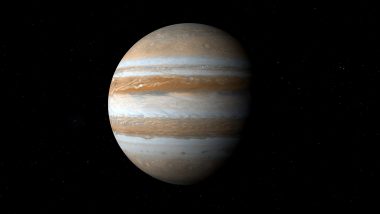Washington, Jan 17: A citizen scientist has discovered a giant gaseous planet about 379 light-years from Earth, orbiting a star with the same mass as the Sun, NASA has said.
The exoplanet, called TOI-2180 b, was discovered in data from NASA's Transiting Exoplanet Survey Satellite (TESS).
TOI-2180 b is almost three times more massive than Jupiter but has the same diameter, meaning it is more dense than Jupiter. This made scientists wonder whether it formed in a different way than Jupiter. The Earth’s Interior is Cooling Faster Than Expected, Says Research.
Further, through computer models the team determined that the new planet may have as much as 105 Earth masses worth of elements heavier than hydrogen and helium.
"That's a lot. That's more than what we suspect is inside Jupiter," said Paul Dalba, astronomer at the University of California, Riverside, and lead author of the study.
The Jupiter-size planet is special for astronomers because its 261-day year is long compared to many known gas giants outside our solar system.
With an average temperature of about 170 degrees Fahrenheit, TOI-2180 b is also warmer than room temperature on Earth, and warmer than the outer planets of our solar system including Jupiter and Saturn.
But compared to the array of transiting giant exoplanets that astronomers have found orbiting other stars, TOI-2180 b is abnormally chilly, NASA said.
The result, published in the Astronomical Journal, also suggests the planet is just a bit farther from its star than Venus is from the Sun.
To track the planet, professional astronomers and citizen scientists engaged in "a global uniting effort".
Using TESS data, scientists looked for changes in brightness of nearby stars, which indicated the presence of orbiting planets.
"Discovering and publishing TOI-2180 b was a great group effort demonstrating that professional astronomers and seasoned citizen scientists can successfully work together," said Tom Jacobs of Bellevue, Washington, a former US naval officer who discovered the exoplanet.
While professional astronomers use algorithms to scan tens of thousands of data points from stars automatically, these citizen scientists use a programme called LcTools, to inspect telescope data by eye.
On February 1, 2020, Jacobs noticed a plot showing starlight from TOI-2180 dim by less than half a percent and then return to its previous brightness level over a 24-hour period, which may be explained by an orbiting planet that is said to acetransit" as it passes in front of the star from our point of view, NASA said.
With 27 hours of observations spread over more than 500 days, the team measured the amount of light that dims as the planet passes. This helped scientists to estimate how big the planet is and its density.
The team wanted to observe the planet's transit when it came back around to confirm the orbit, but they couldn't.
The lack of a clear detection put a boundary on how long the orbit could be, indicating a period of about 261 days.
Using that estimate, they predict TESS will see the planet transit its star again in February 2022, NASA said.
(The above story first appeared on LatestLY on Jan 17, 2022 12:23 PM IST. For more news and updates on politics, world, sports, entertainment and lifestyle, log on to our website latestly.com).













 Quickly
Quickly











